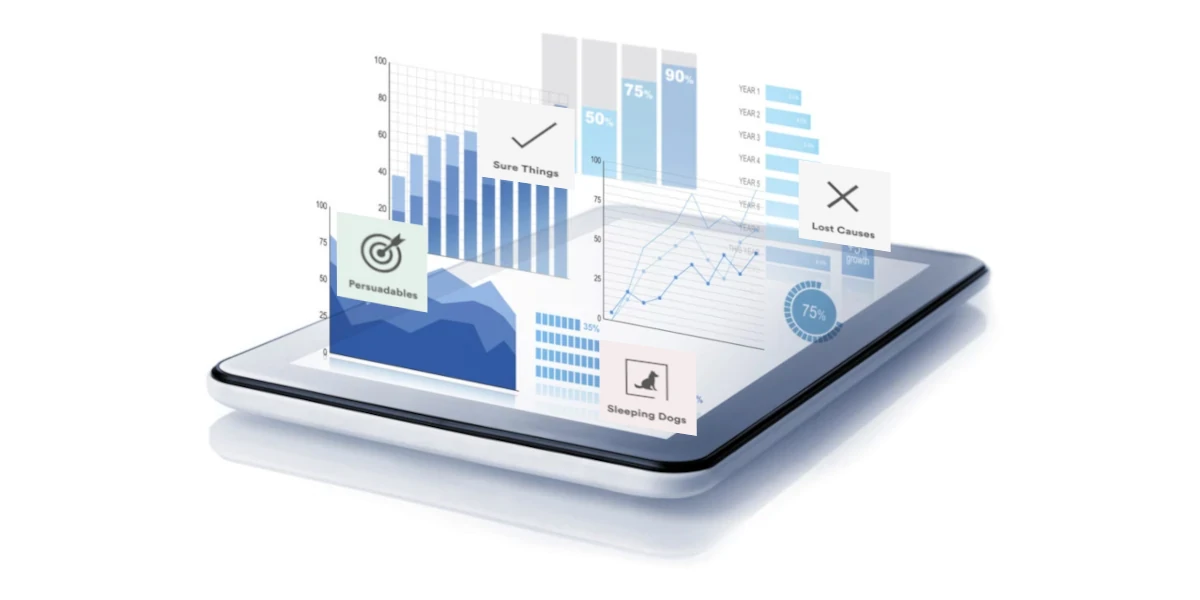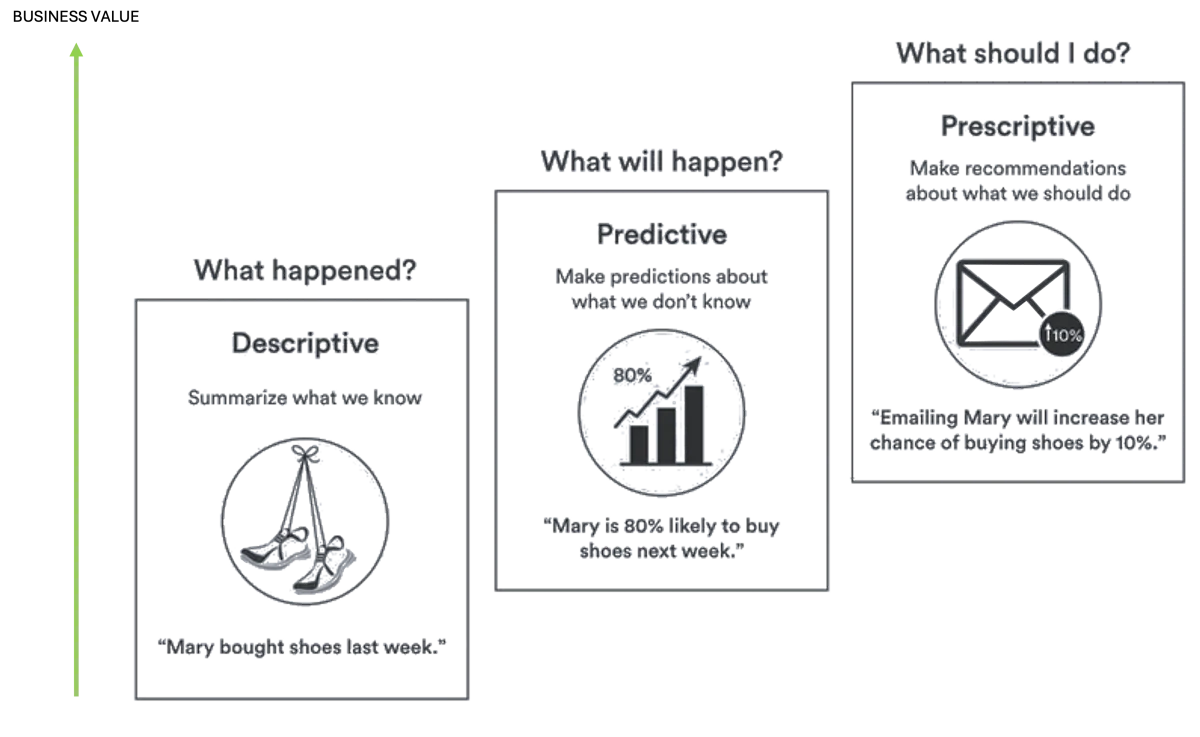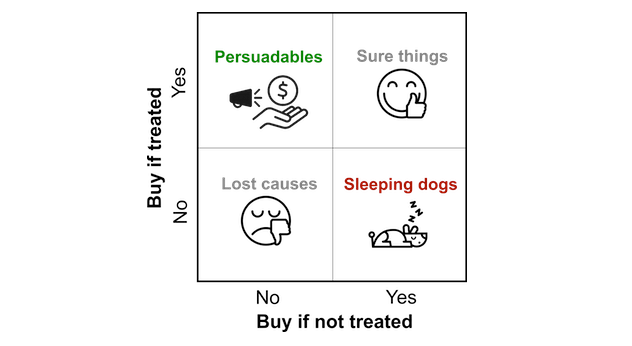Uplift Modeling in Ecommerce Email Marketing

Image source: Cardinal Path
Summary
The key question for any marketing campaign is whether it created an uplift—did it increase customer purchases beyond what would have occurred without it? Companies like Uber, Wayfair, and Fidelity Investments are just a few of the many that rely on Uplift Modeling to find the answer to this question.
In this article, we’ll show you how incorporating simple uplift models can significantly boost your email marketing strategy.
If you’re a brand owner or marketing manager not yet using uplift modeling, you’re missing out on a great chance to improve your marketing efforts.

The art of marketing meets data modelling
Marketing has transformed from an art into a blend of art and science, employing machine learning techniques to uncover customer needs and preferences and then strategically acting on these insights.
This evolution is propelled by the rapid rise of machine learning and data modeling techniques, as outlined below:

Image Source: Twards Data Science
The image above categorizes the three main types of machine learning techniques used by marketers:
Descriptive analytics summarize raw data to uncover patterns and trends from historical data, providing insights into past consumer behaviors like purchase patterns and website traffic (Examples: Google Analytics, Mixpanel).
Predictive analytics build on this by using statistical models to forecast future customer behaviors and trends, aiding in targeting and personalization (Examples: Klaviyo, Bluecore).
Prescriptive analytics merge insights from both to recommend optimal actions, using algorithms to simulate outcomes and guide decision-making in marketing, from campaign management to content creation (Examples: Dynamic Yield, Obviyo).
Together, these analytics transform data into strategic actions to enhance marketing effectiveness.
Why uplift modelling?
In ecommerce email marketing, you encounter customers with many attributes beyond your control, such as demographics or time since their last purchase. You must rely on educated guesses regarding aspects you can influence, such as email design, value propositions, product recommendations, or coupons.
You might wonder:
• How much will this customer buy if we send an email without any incentives?
• How much will they buy if we offer them free shipping?
• How much will they buy if we give them a $10 coupon?
The answer is provided by what could be likened to a ‘crystal ball’, a prescriptive analytics that uses uplift modeling to analyze the attributes you can’t control, such as demographics and time since last purchase, and to estimate the impact of actions within your control, like sending a discount or offering free shipping.
“… In other words, incorporating uplift modeling into your email marketing helps pinpoint a better product-market fit and reduce marketing costs by identifying whom to contact, which products to highlight, and when to offer discount coupons.”
How Uplift Modeling works?
The goal of Uplift Modeling is to predict the incremental change in behavior caused by a marketing intervention, such as targeting a specific audience with an email offer.
The simplest approach to uplift modeling involves sending an offer to a subset of an email list (the ‘test’ group) while withholding it from others (the ‘control’ group). These two groups should be as similar as possible in all other respects.
After conducting your test, you can use email contacts’ attributes and the uplift measurements to categorize your contacts into four groups, as shown below:

Image Source: Ambiata
Sure Things (or Always-Takers) are customers who would have purchased the product regardless of whether they received a email offer.
Persuadables (or Compliers) are customers who became more likely to buy the product because they received an email offer.
Sleeping Dogs (or Defiers) are customers who became less likely to buy the product due to the email offer.
Lost Causes (or Never-Takers) are customers who were never going to buy the product, regardless of whether they received an email offer.
Based on the results above, sending an email offer makes sense only for the contacts in the Persuadables segment.
What are the benefits of Uplift Modeling in ecommerce email marketing?
Uplift Modeling is becoming a game changer in ecommerce email marketing:
Targeted Campaigns: Uplift modeling identifies customers most likely to respond positively to a campaign, ensuring effective targeting and minimizing effort on less responsive segments.
Improved ROI: Uplift modeling boosts ROI by focusing on persuadable customers, reducing unnecessary spending on sure things and lost causes.
Customer Retention: By predicting which customers might churn, uplift modeling aids in developing targeted retention strategies.
Efficiency and Cost-Effectiveness: It streamlines resource allocation, targeting those most likely to be influenced by the campaign, thus optimizing marketing spend.
Enhanced Customer Insights: Uplift modeling offers deeper insights into customer behaviors and preferences, improving understanding of the factors that influence buying decisions.
Personalization: It allows for the customization of campaigns to meet the unique needs and preferences of different customer segments, improving engagement and customer experience.
These benefits help ecommerce businesses not only to increase immediate sales but also to build longer-term customer loyalty and engagement, which are crucial for sustained growth.
Why isn’t everyone doing Uplift Modeling?
Despite its high value, Uplift Modeling in ecommerce email marketing isn’t universally adopted yet due to several obstacles that the average ecommerce company struggles to overcome:

Skill Set Barrier: Implementing uplift modeling requires an understanding of both data science and marketing strategy, presenting a challenge for teams without the necessary expertise.
Data Fragmentation: Effective uplift modeling in ecommerce relies on integrated customer and purchase behavior data, which can be lacking due to the fragmented nature of ecommerce systems and marketing applications.
Resource Constraints: Marketing teams often lack the time and resources needed for the ongoing testing and refinement of marketing campaigns.
Metric Familiarity: Traditional marketing teams are accustomed to simpler, more direct metrics like click-through rates or conversion rates. Shifting to uplift modeling requires not only new tools but also a change in mindset, focusing on long-term customer behavior patterns rather than immediate results.
Cultural Shift: Adopting uplift modeling necessitates a cultural transformation within the company to embrace data-driven decision-making.
Overcoming these obstacles requires significant changes across multiple levels of an organization, which can delay or even prevent its adoption.
Uplift Modeling as an app
To facilitate mass market adoption of Uplift Modeling in email marketing, Obviyo has developed an analytics application that delivers an instant, out-of-the-box solution:

No Skill Set Required: This AI-powered analytics app autonomously generates easy-to-understand insights and recommendations—no expertise needed.
No Data Fragmentation: The app seamlessly integrates disjointed data sources, bridging the gap between email and ecommerce analytics.
No Resource Constraints: No additional burden on marketing team. The app continuously tests email results against site-wide metrics to automatically generate recommendations for optimizing email marketing.
Metric Familiarity: To ensure users are comfortable with the results, the application uses a scoring system similar to the credit scores familiar to anyone applying for financing.
Cultural Shift: There’s no need to change processes or secure a budget. Anyone with access to Google Analytics can start using the free version of the app.
To reiterate, the app is super simple to activate, easy to use, and comes with a high-value free plan.
Get your FREE Email Uplift Score!
Unlock the hidden revenue potential of your email marketing:
- Increase email engagement.
- Use the most effective landing pages.
- Promote the right products.
- Fully monetize every store visit.
Request to join the Beta Program.




